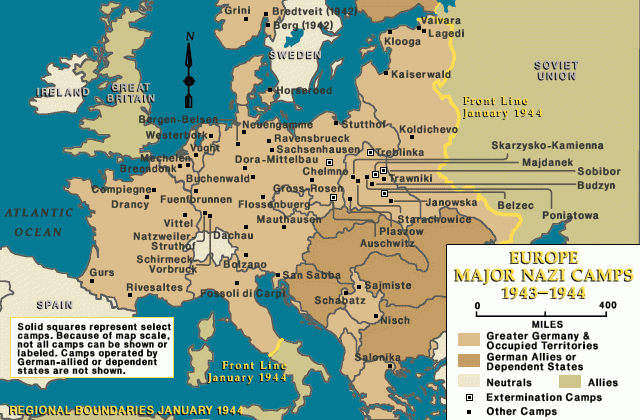
The Holocaust is one of the most frequently discussed and researched topics of the Second World War. It is considered one of the largest genocides in history. The library has compiled sources for you in order to further your understanding on the topic, and teach you how to make sure such a brutal event never happens again, as George Santayana once said: "Those who cannot remember the past are condemned to repeat it." - Sean Hicks, 2025 Senior Intern



















Click here to access Destiny to browse our selection of library materials, or use the image above to begin a search.

Hungarian women being marched by guards at Auschwitz's women's camp, circa 1944. Courtesy of Yad Vashem, Wikimedia Commons (public domain).

Hungarian women being marched by guards at Auschwitz's women's camp, circa 1944. Courtesy of Yad Vashem, Wikimedia Commons (public domain).

Hungarian women being marched by guards at Auschwitz's women's camp, circa 1944. Courtesy of Yad Vashem, Wikimedia Commons (public domain).

The view of a fence by the barracks of Bergen-Belsen's men's camp shortly after it's liberation, 1945. Courtesy of Wikimedia Commons (public domain).

A group of male inmates behind Auschwitz's barbed wire shortly after being liberated by Soviet troops, 1945. Courtesy of Wikimedia Commons (public domain).

In an display of the diversity of the inmate population in concentration camps, in this photo taken at Ravensbrück, in the center stands Nadine Hwang, the daughter of a Chinese diplomat and a Belgian woman, making her one of the very few Asian inmates, and in front of her is Elsie Azzinaro, an American woman who was arrested while visiting family in Italy, making her one of the rare American inmates. Photo taken by Nils A. Blanck (public domain).

New arrivals to Auschwitz get sorted by guards and inmate functionaries, circa 1942. Photo captured by Bernard Walter (public domain).

A still photo featuring actresses Barbara Fijewska and Maria Winogradowa from the Polish movie The Last Step (1948), which was directed by Wanda Jakubowska, who was a survivor of Auschwitz herself. The movie was filmed on the original camp grounds, and cast mostly by other survivors, wearing original uniforms. The stills from the movie are often erroneously touted as real images of the Holocaust. Courtesy of Wikimedia Commons (public domain).

A group of wounded Soviet soldiers in Tarnopol, Ukrainian SSR, with a nurse capture by German troops during Operation Barbarossa, summer of 1941, sitting in the back of an Opel Blitz. Unlike POWs from the Western Allies, who were sent to POW camps and treated in accordance with the Geneva Convention, Soviet POWs were considered subhuman and therefore sent to concentration camps, where they were worked to death. Courtesy of Pixpast (public domain).

In a photo depicting the victory of the oppressed over the oppressors, Zdének Syrovátka, a Czech inmate who was imprisoned at Buchenwald singles out an Oberscharführer who was captured in combat to his liberators who was actually a brutal guard hiding among regular German soldiers in an attempt to escape justice, 1945. Photo by Harold M. Roberts, U.S. Signal Corps (public domain).

Female guards having the time of their lives with their (officially forbidden) boyfriends from the SS-TV, at Solahütte, the luxury resort of Auschwitz guards. At the same exact time, hundreds of thousands of inmates were suffering and toiling in the camp to uphold their luxurious lifestyle. Circa 1944. Photo was found in the infamous Höcker Album (public domain).

In this photo, women and children who were being shipped via train to Bergen-Belsen have escaped their train carts with the help of advancing US troops, narrowly avoiding near certain death upon their arrival, 1945. Courtesy of George C. Gross' estate (public domain).

A Holocaust survivor shows his camp tattoo which is still in his arm 68 years after his liberation in 1945, at an event in Stockholm, Sweden, to recognize Holocaust Remembrance Day. Photo taken by Frankie Fouganthin, 2013, uploaded to Wikimedia Commons (CC 3.0).

One of the infamous 'Death Marches', consisting of inmates and guards from Dachau, Germany, 1945. Image courtesy of Yad Vashem (public domain).

This a photo of how concentration camp barracks were typically organized. There'd be two rows of wooden racks for inmates to sleep on, with a large bench in the middle for inmates to sit and interact in. At the front or rear would be the private room of that barracks' Kapo. There were no bathrooms, so a bucket would be provided. In the morning, the Kapo would make an inmate dump it outside. Courtsey of Wikimedia Commons (public domain).

A group of recently released women at the Danish border who were imprisoned at Ravensbrück, as a part of a deal with the Swedish Red Cross. Relatively speaking, these women are some of the better dressed inmates who aren't Kapos. Circa 1945. Image from USHMM, courtesy of Sigmund Baum (public domain).

Map courtesy of USHMM.




















